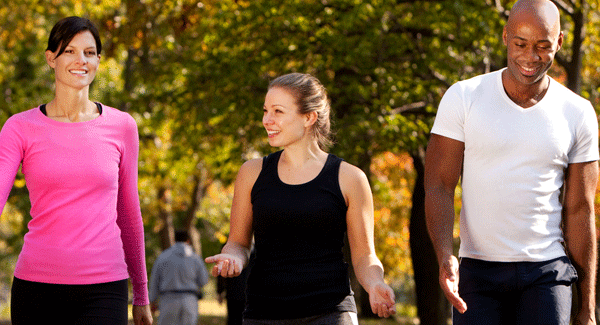Golfing With Arthritis
Get smart tips to adjust your swing, warm up and keep playing golf even with arthritis.
There’s no need to hang up your golf clubs once you’ve been diagnosed with arthritis. After all, the physical benefits of golf, such as improved strength, balance and coordination, and better range of motion, make it worth staying in the game. With just a few adjustments, you can improve your golf swing.
Warm Up
A good conditioning program is essential for all golfers, but especially if your joints need extra protection. Proper conditioning can help maintain as much range of motion as possible in the joints and help reduce your chances for injury. And warming up before you workout – including prior to tee times – is a must to properly help protect and prepare muscles and joints.
To warm up, begin by walking for a few minutes. Spend five to 10 minutes stretching – especially your hamstrings (rear thighs) and back.
Range-of-Motion Exercises
Simple range-of-motion exercises before you tee off are also recommended and can help prevent injury and improve the overall performance of your game. Here are a few exercises to help you get started.
Range of Motion
Lift arms straight out to your sides at shoulder height. Move arms in a circular motion, gradually increasing the size of the circles. Reverse direction after 30 seconds.
With arms at your sides and elbows bent at 90 degrees, twist your torso and head to the left as if you’re looking over your shoulder and hold for five seconds. Be sure to twist from the waist. Return to starting position.
Place feet shoulder width apart. Using two hands, hold a club at opposite ends and raise it above your head. Lean your torso to one side to feel the stretch on the opposite side. Repeat 10 times on each side leaning your torso a little farther each time.
Take 10 to 15 slow three-quarter swings on the practice range before the first tee. Start out by hitting higher lofted clubs, like a pitching wedge, and begin by swinging 50 percent to 75 percent.
Golfing Tips
Play from the 150-yard markers if you begin to get tired. Consider using energy-saving techniques while you’re on the course. Take only the clubs you use most frequently. Pull your golf bag instead of carrying it, or rent a motorized cart instead of walking.
Keep your tension on the shaft consistent. Be careful not to let your arms and trunk become too rigid.
If you have back pain, you may find that the classic swing is more comfortable for you than the modern swing or reverse-C swing.
End it early – at the three o’clock position, rather than the one o’clock position – to prevent back, shoulder and elbow injuries. Always brush through the grass so you will hit the ball solidly and carry your momentum out to the target.
Focus on sweeping through the ball. Transferring weight from one leg to the other is easier if you allow your heels to lift – and it also results in a more effective shot. Let the natural momentum of the swing continue into the follow-through position.
When you stop, your spine should be as vertical as possible to minimize the load on the lumbar spine.
Whether you’re a veteran golfer or a beginner, consult your doctor or physical therapist before hitting the greens. An occupational therapist also can help advise you about any special aids or adaptive tools.
Dean Claggett, director of golf at Two Eagles Golf and Academy in West Kelowna, British Columbia, and Shandia Cordingley, a physical therapist at Dale Charles Physiotherapy in Penticton, British Columbia, worked with the Arthritis Society in Canada to develop these golf swing tips specifically for golfers with arthritis.
Gear Up
Use clubs with lightweight graphite shafts and perimeter-weighted heads to help absorb shock. Take only the clubs you’ll use during the game to lighten the load of your golf bag.
Get a golf bag with a wheeled cart so you can push the bag instead of pulling or carrying it.
Use a lower compression golf ball (for example, a 90 instead of a 100) so there is more “give” to the ball when you hit it.
Use long tees whenever you hit the ball – even on the practice range. Long tees let you stand taller and help protect hand and wrist joints by reducing the chance of striking the ground with the club and jarring your joints. Tees can be used even on the fairway.
Wear good-quality walking shoes or spike-less golf shoes to keep feet comfortable and reduce the chance of catching your foot and tripping. Extra cushioning or orthotics in shoes may also help decrease aches and pains as you walk the course.
Wearing gloves on both hands provides extra grip without having to increase pressure. Bionic Golf Gloves ($25, www.bionicgloves.com) have special pads to help ease hand pain and fatigue while improving grip strength.
Build up the grip size on your clubs with athletic tape or a custom grip to help you hold them easier and to reduce stress and pain on your finger joints. If you have arthritis in your hands, try wearing wrist braces and gloves on both hands to stabilize your joints.
Whether you’re a veteran golfer or a beginner, consult your doctor or physical therapist before hitting the greens. An occupational therapist also can help advise you about any special aids or adaptive tools.
Adaptation is the key to playing golf with arthritis and good golf equipment can go a long way to keeping you on the fairway. Grips, shoes, balls, clubs and more can be adjusted to fit your specific needs and abilities. In addition to the tips on golf gear listed below, your local pro shop or golf specialty store also can help you keep up-to-date on the latest products to make golfing easier on your joints.

Stay in the Know. Live in the Yes.
Get involved with the arthritis community. Tell us a little about yourself and, based on your interests, you’ll receive emails packed with the latest information and resources to live your best life and connect with others.


